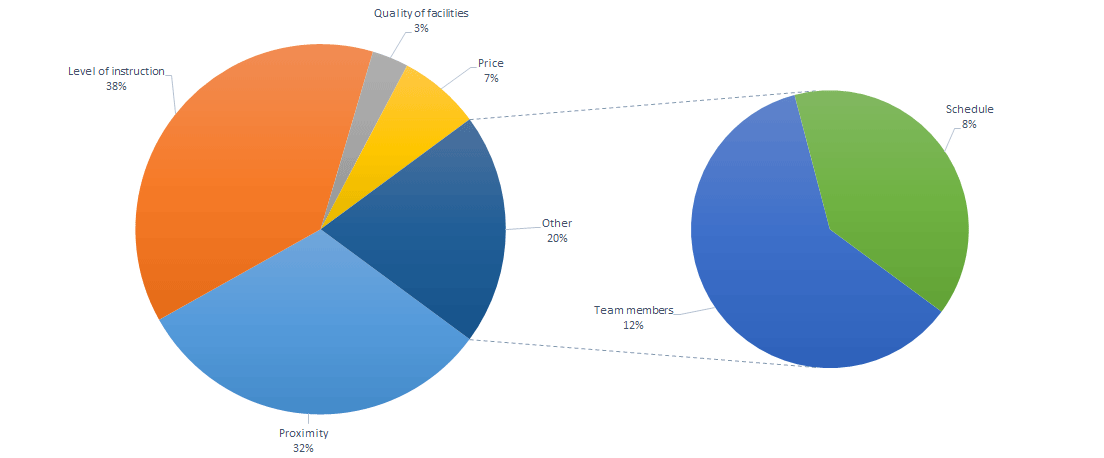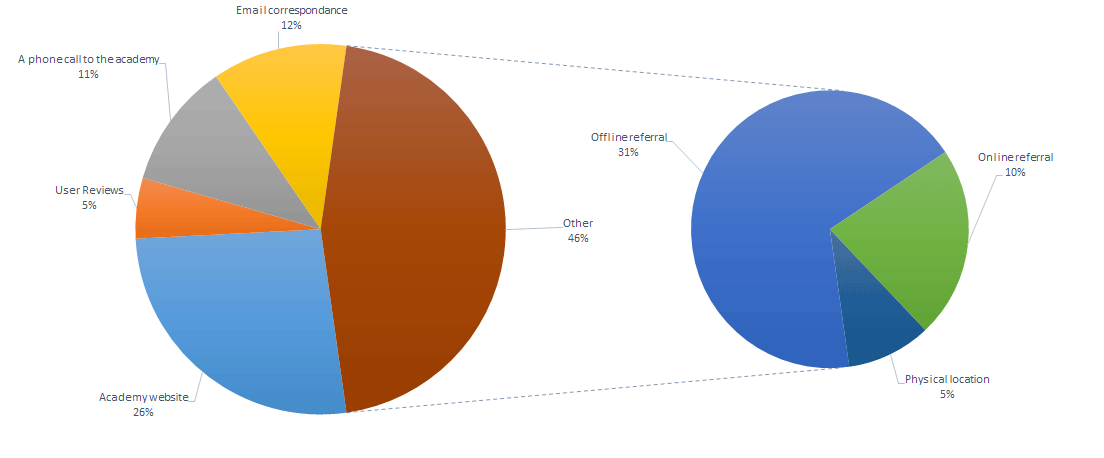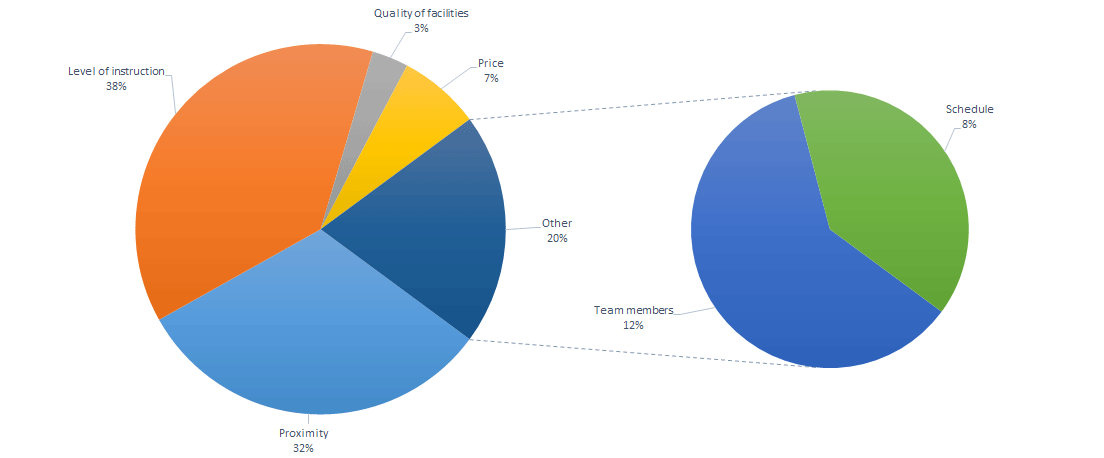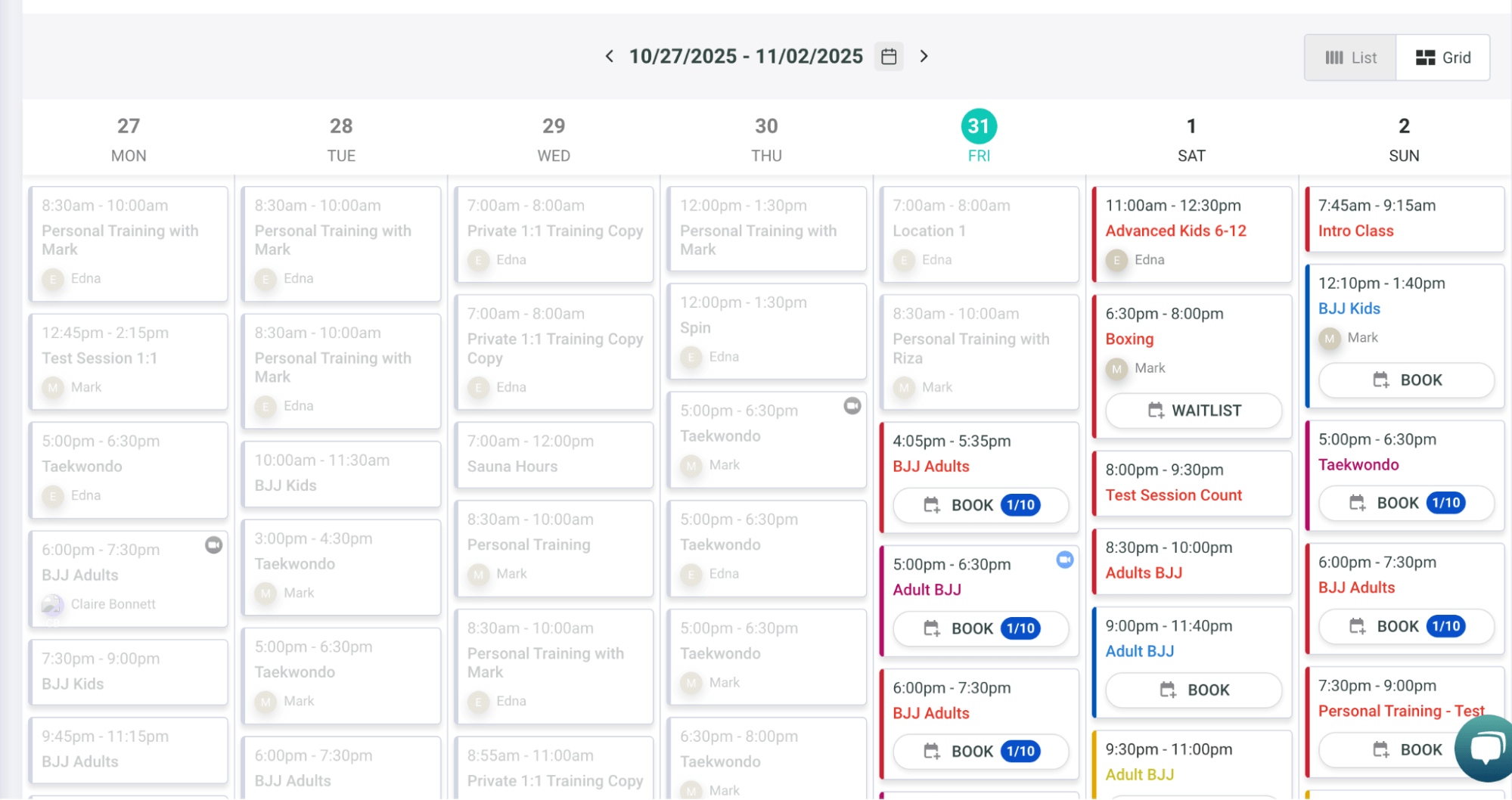How People Find Your Martial Arts Gym

The survival and growth of a martial arts gym is tied closely to the influx of new members. Members pay the bills, and without a steady flow of new ones, a school cannot grow or even maintain its current status, as there is a constant churn of existing members.To understand how prospective members might find your place, we ran a survey on Reddit's BJJ community. Being that the results are from an online community, you would expect the data to somewhat prefer online acquisition channels. However, I believe it is still representative of how most people conduct their martial arts school search.You can view the results of the survey hereThe marketing term for the process in which you convert potential customers to actual clients, is called the funnel. In the survey, we broke down the funnel for acquiring new members into 3 sections:
- Visibility - how do new members find your gym?
- Attractiveness - what makes prospective members walk through the door?
- Conversion - what makes people sign on as new members?
For your convenience, we summed up the results in a SlideShare presentation. To read more in-depth analysis, keep reading the text below.
Part 1 - How do people find martial arts schools
We identified 8 main acquisition channels used to find martial arts schools. In the original poll, we didn't put "Physical location" as an option, however a significant amount of people added it in using the "Other" option, so we added those up and put it as another channel in the results.
Online
- Search engines
- Map services (Google Maps, Bing, etc)
- Online communities (Reddit, forums)
- Social media (Facebook, Twitter, Google+)
- Ads
Offline
- Recommendations / referrals
- Physical location
- Ads
After cleaning up the survey results, this is how the distribution looks for each channel:

As can be seen, online search is by and far the most common way to find new martial arts academies. If you combine that with maps search (Google maps, Bing maps, etc), you reach an astounding 63% of all acquisition channels. By far, online search visibility is where you can make the most impact to your overall gym visibility.
In second place, we have referrals / recommendations (21%). Since online communities and social media are counted separately, this includes mainly word-of-mouth referrals from people who personally know the members.
If members at your gym are happy with the service you are providing, they would be naturally inclined to recommend it to other people. In addition, having some kind of referral program - either with actual rewards, or just actively reminding members to bring people in to try the place out - can have a significant positive impact on member growth.
Social media and ads of any kind came in surprisingly marginal as acquisition channels. Not many martial arts academies run ads so that's likely a big reason why that channel ranks so low, however almost every gym I attended was making significant efforts on social media - especially Facebook and Twitter, yet it seems the value for attracting new members is not high (Social media can be great for member retention and communication, however).
As for the physical location of the gym, it seems it's not a huge factor as far as visibility (proximity to people's home / work is more important, as we'll see below).(We will discuss in depth all of those acquisition channels and how to optimize it in future articles.)
Part 2 - Getting people inside the gym
Now that we have a general understanding on how people find martial arts schools, let's take a look at what makes them visit the physical location.

As before, some cleanup was done on the numbers to slot the responses under "Other" into the correct categories, so they might vary a bit from what you see in the link posted at the beginning of the article.
We learn some interesting things from the survey - even though only 21% of martial arts practitioners heard about their current school through a referral, 41% decided to visit the actual location because of it. This means that prospective members will often try to get some validation about your school from someone they trust, even if they heard about it through another source. In short, your gym's reputation and the happiness of current members are extremely important for attracting new members.
The academy website accounted for another 26% of visitors. In addition, 12% decided to visit after an Email correspondence, which can also be attributed mainly to the academy website. That's around 38% of visitors coming as a result of going through the academy website, highlighting its importance.
11% of visitors came in after talking to someone from the academy on the phone. Coupled with the 12% who sent an Email, that brings it to 23% who came to visit after direct communication with someone in the academy. You should always have someone answering inbound inquiries with professionalism and urgency. I know I've personally skipped on visiting places that didn't answer their phone or reply to my Emails.
On the other hand, we can see that online user reviews had a fairly minor effect on incoming visitor traffic. Though it doesn't hurt to have high rankings on sites such as Yelp and Google+, I've seen many academy owners put too much effort on that front which is not proportional to the benefit they receive from it. As long as you keep it fairly clean of bad reviews, you should be fine.
Part 3 - Signing the contract
The last part in the funnel is converting a visitor into a member. There are many factors that go into such a decision - such as schedule, pricing, location, facilities, instruction and more. We wanted to see what was the most important factor for each visitor, and thus the survey we ran forced participants to pick only one.

Immediately apparent is that two factors dominate the rest - instruction and location. Worth noting that in "Level of instruction" I included answers that voted for the instructor's attitude, teaching style and not necessarily his/hers accolades. The academy staff is the most important factor for a visitor deciding whether or not to join the team.
Closely behind is the visitor's proximity to the gym. This is especially true for fresh beginners, as they have less tools with which to determine how good the instruction is.
The composition of the team is the next closest at 12%. I put answers that noted the school's atmosphere under this category as well. The make-up and attitude of the team is often influenced by the people at the top - the instructors, so a strong leadership and cultivating gym culture are important for creating a healthy and inviting atmosphere for new members.
The other factors - price, schedule and facilities - all together affected around 18% of the visitors' decision to sign-up. I'd expect those numbers are higher in areas that are densely populated with martial arts schools, and the options are plenty - for example, San Diego for BJJ training - but otherwise, unless there is a huge disparity in those areas, those factors are less important compared to the 2 big ones mentioned above.
Bonus chart - why do people look for a place to train?
We included an additional, optional question at the end of the survey about the reason people were looking for a place to train.

You may or may not find it surprising, but "self-defense" is the least important reason by a considerable margin. Considering the importance most academies put on that in their branding and marketing materials, it doesn't seem to have the appeal you might think it does.
Along the same lines, the amount of people who want to start training due to the appreciation of martial arts or being fans of MMA, is pretty high. MMA has grown immensely as a sport over the last couple of decades, and many people were exposed to how "real" martial arts look like through it. As this survey was ran on the BJJ reddit community, it's not surprising to see that as a major reason for starting to train.
Footnote: I ran the same survey on the Judo reddit community, however I did not get enough responses to make a relevant analysis. If you're interested in those results, they are available here.
Closing Words
The analysis in this article is based on over 260 responses from the BJJ community on reddit. It likely contains some bias, for example - online channels might be over-represented, and people training in other arts might have somewhat different reasons for doing so. However, I do believe it's fairly accurate overall, considering the number of responses received.
Your own school's numbers likely look significantly different than those in the article. If you keep track of how new members find your place, it can give you a good indication of where you could do better to improve the growth of your school.
Obligatory plug: I wrote this article since the topic is close to my heart. In the platform we have built for managing martial arts schools, we address and optimize many of the points mentioned in this article - including the actual tracking of the channels members come through. If you are the owner or a manager of a martial arts gym, you might be interested in taking a look.
Next up
In the next article I'll start breaking down individual acquisition channels, such as search visibility and online community presence, and lay down some best practices for each with a martial arts focus.
Gym management software that frees up your time and helps you grow.
Simplified billing, enrollment, student management, and marketing features that help you grow your gym or martial arts school.





